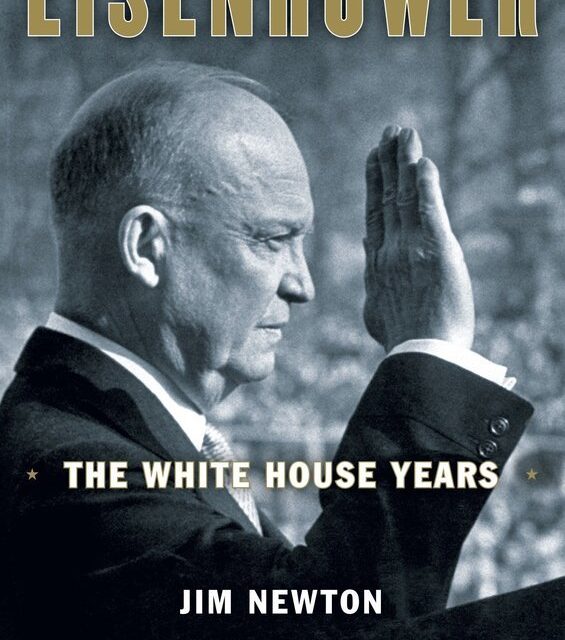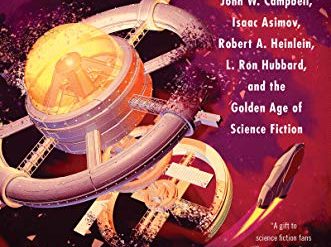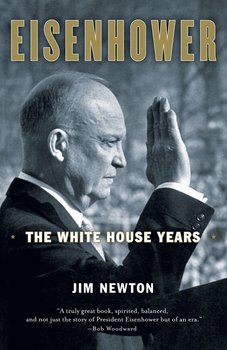
The earthshaking events of the 1960s and the cataclysm of World War II have led many of us to think about the 1950s as a boring period when little of importance happened. It was a time between epochal events. And as Jim Newton explains in his superb biography of Dwight Eisenhower during his eight years in the White House, the 1950s were notable mostly because of what didn’t happen. Despite the ferocity of the Cold War and the brinkmanship of Secretary of State John Foster Dulles, the decade never witnessed the further use of nuclear weapons. And that, Newton makes clear, was because President Eisenhower sat in the Oval Office.
A time of great consequence
In fact, the period that spanned the years from the Korean War to the election of John F. Kennedy as president was a time of great consequence.
US-Soviet relations were roiled by the death of Stalin, Khrushchev’s “Secret Speech,” the Hungarian Revolution, the brinkmanship between the US and China over the Taiwanese islands of Quemoy and Matsu, and the downing of the American U-2 spy plane.
Acting at President Eisenhower’s behest, the Dulles brothers directed the covert action that felled Mohammed Mossadegh in Iran, Jacobo Arbenz in Guatemala, and Patrice Lumumba in the Congo.
The civil rights revolution intensified with Brown v. Board of Education, the trial of Emmett Till, the Montgomery Bus Boycott, and the dispatch of federal troops to permit Black students to enter Little Rock Central High School.
And anti-Communist hysteria racked the nation, with the execution of Julius and Ethel Rosenberg, the bogus revelations of the Army-McCarthy hearings, and the hysterical claims of the House Un-American Activities Committee.
Headline-grabbing events from start to finish
But there was much, much more. Here, for example, are some of the other events that crowded newspaper headlines as the years went by under the administration of President Eisenhower:
- Congress funded the Interstate Highway System, the biggest public works project in the nation’s history, and the St. Lawrence Seaway, which opened the Midwest to the world.
- The president suffered a heart attack and, later, a stroke.
- Hawaii and Alaska became the 49th and 50th states.
- Jonas Salk completed his polio vaccine.
- The USSR took the world with surprise with the flight of Sputnik 1, triggering the creation of NASA and the opening of the space race.
- Eisenhower forced Britain, France, and Israel to back down in the Suez Canal crisis.
- Puerto Rican nationalists shot up the House of Representatives.
- 500,000 steelworkers went out on strike.
- And the decade ended with the Cuban Revolution, prompting the Administration to plan the ill-fated Bay of Pigs invasion.
Eisenhower: The White House Years by Jim Newton (2011) 464 pages ★★★★★
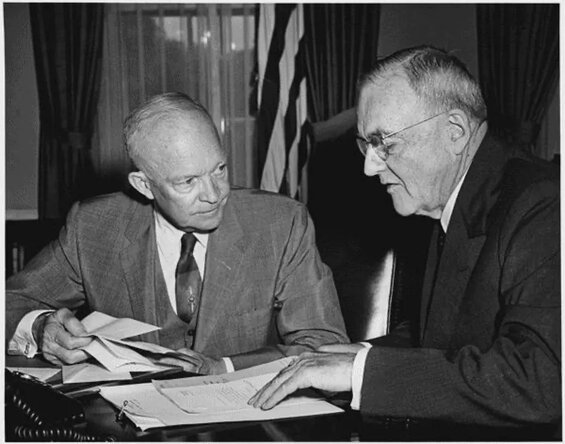
A fateful eight years in historic perspective
After briefly surveying President Eisenhower’s childhood and his later life as a soldier, Newton dips into the circumstances surrounding all these events listed above and Eisenhower’s role in connection with them. But he puts his account, and the eight years the former commanding general served in the Oval Office, into historic perspective. As the Soviet Union gained access not just to the atomic bomb but to the H-bomb as well, “annihilation still loomed, yet precisely one American died in combat, killed by a sniper in Lebanon. No American president of modern times had brought to the office greater skill as a soldier, yet none had done more to preserve the peace.” One. Single. American. Soldier. Think of what has followed almost continuously ever since.
He was “commandingly the boss”
Eisenhower was often viewed as a weak president with an exaggerated fondness for golf and contract bridge with his wealthy cronies in “The Gang.” Newton’s view is different. He emphasizes throughout that the strong men in Eisenhower’s cabinet and on his staff were invariably acting on the president’s direct orders when they took steps the press attributed solely to them. Eisenhower was, in the author’s words, “commandingly their boss.” For example, the covert action spearheaded by Allen Dulles at the CIA and his brother Foster at State was not their project but the president’s.
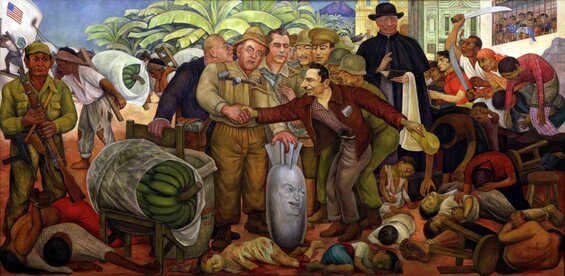
“Little Ike” to his five brothers
Far less well known to the public, either at the time or since, was the continuing influence of President Eisenhower’s family on his life and conduct. His mother was a Mennonite pacifist who cried when he left for West Point in 1911. He was “still just one of the six Eisenhower boys.” Ike was known in the family as “Little Ike” throughout his life to distinguish him from his older brother Edgar, who was “Big Ike.” Edgar was a reactionary lawyer who subjected the president to a stream of critical letters, objecting to the actions he took on everything from national defense and the McCarthy hearings to civil rights. Younger brother Milton, a university president throughout Eisenhower’s presidency, was much more moderate; Newton characterizes him as “an elegant liberal.” Ike had immense respect for Milton and often turned to him for advice.
A balanced assessment
Newton’s assessment of Dwight Eisenhower is balanced. “He was a good man,” he writes, “one of integrity and decency. But he was not always right. He was too enamored of covert action, and he did not fully apprehend the moral imperatives of civil rights, where his belief in measured progress, the middle way, impeded his sympathy for those who demanded their constitutional rights immediately.” Yet he “registered the nation’s most significant progress on racial equality since the end of the Civil War.”
About the author

Jim Newton began his career in journalist as a clerk to New York Times columnist James Reston. He is the former editor at large of the Los Angeles Times and the author of three biographies: Justice for All, about former California Governor and US Chief Justice Earl Warren, and Man of Tomorrow, about the life of former California Governor Jerry Brown, as well as Eisenhower: The White House Years.
For more reading
I’ve also reviewed Newton’s Man of Tomorrow: The Relentless Life of Jerry Brown (Jerry Brown: politician, would-be monk, “man of tomorrow?”).
You might also be interested in:
- The Brothers: John Foster Dulles, Allen Dulles, and Their Secret World War by Stephen Kinzer (They shaped US foreign policy for decades to come)
- The Devil’s Chessboard: Allen Dulles, the CIA, and the Rise of America’s Secret Government by David Talbot (When America’s secret government ran amok)
- Great biographies I’ve reviewed: my 10 favorites
- Top 20 popular books for understanding American history
And you can always find my most popular reviews, and the most recent ones, plus a guide to this whole site, on the Home Page.

